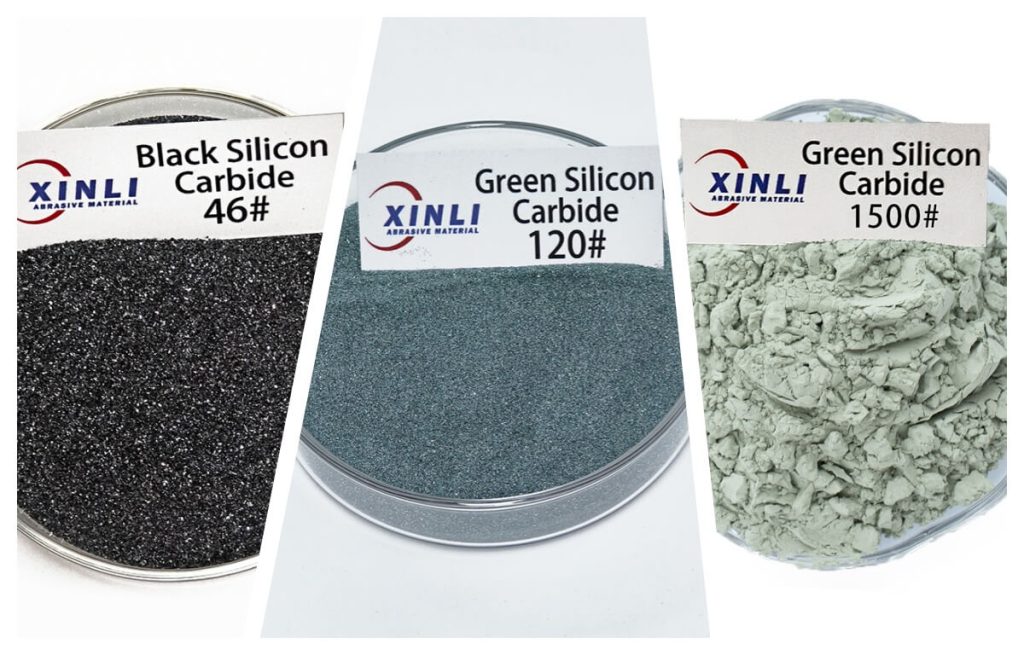Green silicon carbide and black silicon carbide: Deep differences beyond color
In the vast field of industrial materials, green silicon carbide and black silicon carbide are often mentioned together. Both are important abrasives made by high-temperature smelting in resistance furnaces with raw materials such as quartz sand and petroleum coke, but their differences are far more than the color differences on the surface. From the subtle differences in raw materials, to the disparity in performance characteristics, to the vast difference in application scenarios, these differences have jointly shaped the unique roles of the two in the industrial field.
 1 The difference in raw material purity and crystal structure determines the different characteristics of the two.
Green silicon carbide is made of petroleum coke and quartz sand as the main materials, and salt is added for refining. Through this process, the impurity content is minimized to the greatest extent, and the crystal is a regular hexagonal system with sharp edges and corners. The raw material processing of black silicon carbide is relatively simple, and no salt is added. The impurities such as iron and silicon left in the raw materials make its crystal particles irregular in shape and rounded and blunt at the edges and corners.
2 Differences in raw materials and structures lead to different physical properties of the two.
In terms of hardness, the Mohs hardness of green silicon carbide is about 9.5, second only to diamond, and can process high-hardness materials; black silicon carbide is about 9.0, with a slightly lower hardness. In terms of density, green silicon carbide is 3.20-3.25g/cm³, with a dense structure; black silicon carbide is 3.10-3.15g/cm³, relatively loose. In terms of performance, green silicon carbide has high purity, good thermal conductivity, electrical conductivity and high temperature resistance, but it is brittle and easy to break into new edges; black silicon carbide has slightly weaker thermal conductivity and electrical conductivity, low brittleness, and stronger particle impact resistance.
3 Performance differences determine the application focus of the two.
Green silicon carbide has high hardness and sharp particles, and is good at processing high-hardness and low-toughness materials: in the non-metallic field, it can be used for glass grinding, ceramic cutting, semiconductor silicon wafers, and sapphire polishing; in metal processing, it has excellent high-precision processing performance for materials such as cemented carbide and hardened steel, and is widely used in products such as grinding wheels and cutting discs. Black silicon carbide mainly processes low-hardness, high-toughness materials and is suitable for the processing of non-ferrous metals and refractory materials such as cast iron, copper and aluminum. In rough scenes such as deburring castings and rust removal of steel, it has become a common choice in industry due to its high cost-effectiveness.
Although green silicon carbide and black silicon carbide belong to the silicon carbide material system, their physical and chemical properties and application characteristics are significantly different. With the continuous innovation of materials science and processing technology, green silicon carbide and black silicon carbide are expected to achieve wider application expansion in high-tech fields such as semiconductor manufacturing, precision grinding, and new energy, providing key material support for the high-quality development of modern industry.
1 The difference in raw material purity and crystal structure determines the different characteristics of the two.
Green silicon carbide is made of petroleum coke and quartz sand as the main materials, and salt is added for refining. Through this process, the impurity content is minimized to the greatest extent, and the crystal is a regular hexagonal system with sharp edges and corners. The raw material processing of black silicon carbide is relatively simple, and no salt is added. The impurities such as iron and silicon left in the raw materials make its crystal particles irregular in shape and rounded and blunt at the edges and corners.
2 Differences in raw materials and structures lead to different physical properties of the two.
In terms of hardness, the Mohs hardness of green silicon carbide is about 9.5, second only to diamond, and can process high-hardness materials; black silicon carbide is about 9.0, with a slightly lower hardness. In terms of density, green silicon carbide is 3.20-3.25g/cm³, with a dense structure; black silicon carbide is 3.10-3.15g/cm³, relatively loose. In terms of performance, green silicon carbide has high purity, good thermal conductivity, electrical conductivity and high temperature resistance, but it is brittle and easy to break into new edges; black silicon carbide has slightly weaker thermal conductivity and electrical conductivity, low brittleness, and stronger particle impact resistance.
3 Performance differences determine the application focus of the two.
Green silicon carbide has high hardness and sharp particles, and is good at processing high-hardness and low-toughness materials: in the non-metallic field, it can be used for glass grinding, ceramic cutting, semiconductor silicon wafers, and sapphire polishing; in metal processing, it has excellent high-precision processing performance for materials such as cemented carbide and hardened steel, and is widely used in products such as grinding wheels and cutting discs. Black silicon carbide mainly processes low-hardness, high-toughness materials and is suitable for the processing of non-ferrous metals and refractory materials such as cast iron, copper and aluminum. In rough scenes such as deburring castings and rust removal of steel, it has become a common choice in industry due to its high cost-effectiveness.
Although green silicon carbide and black silicon carbide belong to the silicon carbide material system, their physical and chemical properties and application characteristics are significantly different. With the continuous innovation of materials science and processing technology, green silicon carbide and black silicon carbide are expected to achieve wider application expansion in high-tech fields such as semiconductor manufacturing, precision grinding, and new energy, providing key material support for the high-quality development of modern industry.